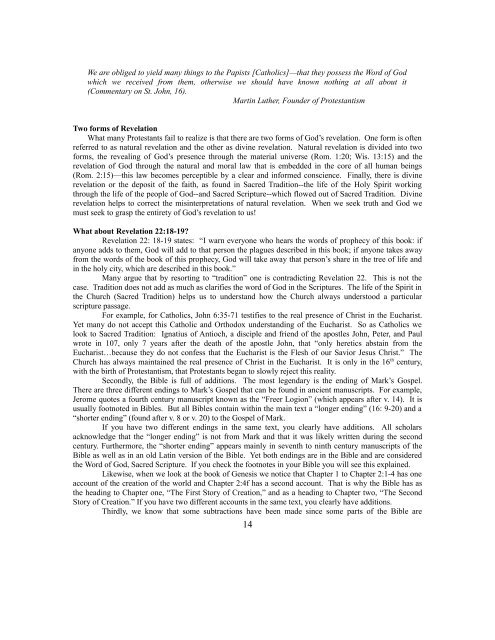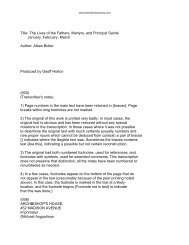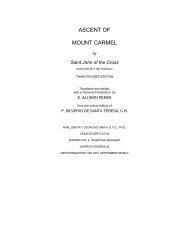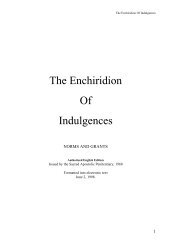Ecce Fides - Pillar of Truth - St. Patrick's Basilica
Ecce Fides - Pillar of Truth - St. Patrick's Basilica
Ecce Fides - Pillar of Truth - St. Patrick's Basilica
Create successful ePaper yourself
Turn your PDF publications into a flip-book with our unique Google optimized e-Paper software.
We are obliged to yield many things to the Papists [Catholics]—that they possess the Word <strong>of</strong> God<br />
which we received from them, otherwise we should have known nothing at all about it<br />
(Commentary on <strong>St</strong>. John, 16).<br />
Martin Luther, Founder <strong>of</strong> Protestantism<br />
Two forms <strong>of</strong> Revelation<br />
What many Protestants fail to realize is that there are two forms <strong>of</strong> God’s revelation. One form is <strong>of</strong>ten<br />
referred to as natural revelation and the other as divine revelation. Natural revelation is divided into two<br />
forms, the revealing <strong>of</strong> God’s presence through the material universe (Rom. 1:20; Wis. 13:15) and the<br />
revelation <strong>of</strong> God through the natural and moral law that is embedded in the core <strong>of</strong> all human beings<br />
(Rom. 2:15)—this law becomes perceptible by a clear and informed conscience. Finally, there is divine<br />
revelation or the deposit <strong>of</strong> the faith, as found in Sacred Tradition--the life <strong>of</strong> the Holy Spirit working<br />
through the life <strong>of</strong> the people <strong>of</strong> God--and Sacred Scripture--which flowed out <strong>of</strong> Sacred Tradition. Divine<br />
revelation helps to correct the misinterpretations <strong>of</strong> natural revelation. When we seek truth and God we<br />
must seek to grasp the entirety <strong>of</strong> God’s revelation to us!<br />
What about Revelation 22:18-19?<br />
Revelation 22: 18-19 states: “I warn everyone who hears the words <strong>of</strong> prophecy <strong>of</strong> this book: if<br />
anyone adds to them, God will add to that person the plagues described in this book; if anyone takes away<br />
from the words <strong>of</strong> the book <strong>of</strong> this prophecy, God will take away that person’s share in the tree <strong>of</strong> life and<br />
in the holy city, which are described in this book.”<br />
Many argue that by resorting to “tradition” one is contradicting Revelation 22. This is not the<br />
case. Tradition does not add as much as clarifies the word <strong>of</strong> God in the Scriptures. The life <strong>of</strong> the Spirit in<br />
the Church (Sacred Tradition) helps us to understand how the Church always understood a particular<br />
scripture passage.<br />
For example, for Catholics, John 6:35-71 testifies to the real presence <strong>of</strong> Christ in the Eucharist.<br />
Yet many do not accept this Catholic and Orthodox understanding <strong>of</strong> the Eucharist. So as Catholics we<br />
look to Sacred Tradition: Ignatius <strong>of</strong> Antioch, a disciple and friend <strong>of</strong> the apostles John, Peter, and Paul<br />
wrote in 107, only 7 years after the death <strong>of</strong> the apostle John, that “only heretics abstain from the<br />
Eucharist…because they do not confess that the Eucharist is the Flesh <strong>of</strong> our Savior Jesus Christ.” The<br />
Church has always maintained the real presence <strong>of</strong> Christ in the Eucharist. It is only in the 16 th century,<br />
with the birth <strong>of</strong> Protestantism, that Protestants began to slowly reject this reality.<br />
Secondly, the Bible is full <strong>of</strong> additions. The most legendary is the ending <strong>of</strong> Mark’s Gospel.<br />
There are three different endings to Mark’s Gospel that can be found in ancient manuscripts. For example,<br />
Jerome quotes a fourth century manuscript known as the “Freer Logion” (which appears after v. 14). It is<br />
usually footnoted in Bibles. But all Bibles contain within the main text a “longer ending” (16: 9-20) and a<br />
“shorter ending” (found after v. 8 or v. 20) to the Gospel <strong>of</strong> Mark.<br />
If you have two different endings in the same text, you clearly have additions. All scholars<br />
acknowledge that the “longer ending” is not from Mark and that it was likely written during the second<br />
century. Furthermore, the “shorter ending” appears mainly in seventh to ninth century manuscripts <strong>of</strong> the<br />
Bible as well as in an old Latin version <strong>of</strong> the Bible. Yet both endings are in the Bible and are considered<br />
the Word <strong>of</strong> God, Sacred Scripture. If you check the footnotes in your Bible you will see this explained.<br />
Likewise, when we look at the book <strong>of</strong> Genesis we notice that Chapter 1 to Chapter 2:1-4 has one<br />
account <strong>of</strong> the creation <strong>of</strong> the world and Chapter 2:4f has a second account. That is why the Bible has as<br />
the heading to Chapter one, “The First <strong>St</strong>ory <strong>of</strong> Creation,” and as a heading to Chapter two, “The Second<br />
<strong>St</strong>ory <strong>of</strong> Creation.” If you have two different accounts in the same text, you clearly have additions.<br />
Thirdly, we know that some subtractions have been made since some parts <strong>of</strong> the Bible are<br />
14






